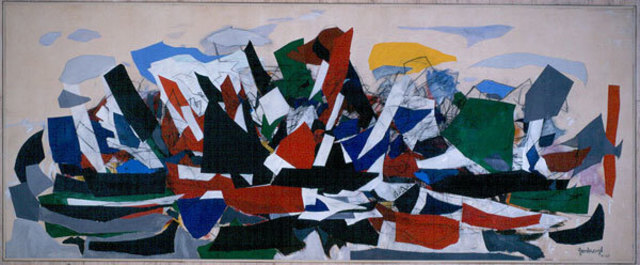
Description
Art historians and critics generally refer to Robert Goodnough as a second-generation Abstract Expressionist. In the early 1950s Goodnough became interested in the technique of collage. Though Struggle is not actually a collage, it has forms that look like cut-out shapes applied to the surface. They are arranged as overlapping planes of color in a flat, shallow space, giving the painting a formal structure related to that of Synthetic Cubism. Strugglealso has an energetic, somewhat chaotic composition that incorporates drips and other "accidents," recalling the more gestural and spontaneous approach of Pollock and Kline. The painting is predominantly nonrepresentational, evoking a feeling of struggle by means of chaotic, overlapping forms and lines concentrated in the center of the painting. Figural and landscape elements are also present. For example, an arm rises out of the mass of forms to the right of center and light blue clouds float above. These fragmented forms, caught in conflict and contrasted with a more peaceful surrounding, reinforce the subject of struggle. The content of this painting, together with its large size and vaguely Cubist style, recalls Picasso's famous tribute to the struggle of the Spanish people against Fascism in his 1937 painting Guernica.
Reproduction of this image, including downloading, is prohibited without written authorization from the artist.
Details
- Work Date:
- 1966-67
- Location:
- South Concourse
- Dimensions:
- 8'-9" x 21'-7"
- Medium:
- charcoal, acrylic, and oil on canvas